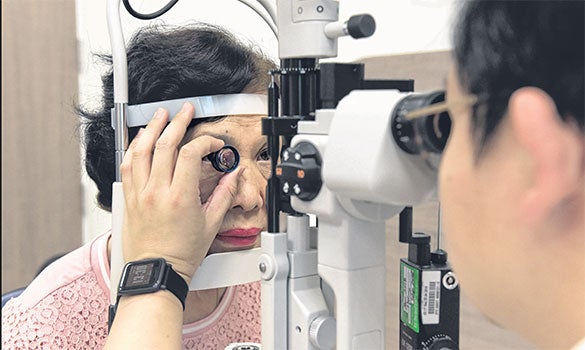
with Madam Kueh Jee Kim.

In addition to better screening, there are now more effective treatment options for diabetic eye diseases, particularly diabetic retinopathy and macular oedema.
Since last year, the oral drug Fenofibrate has been prescribed to patients who are in the middle stage of any diabetic eye disease to slow it down.
Studies have shown that the drug reduces the progression of diabetic retinopathy by at least 50 per cent, and the need for laser treatment by 30 per cent, said Dr Gavin Tan, a consultant at the Singapore National Eye Centre's (SNEC) Surgical Retina Department.
These improvements go a long way in ensuring that patients can maintain their quality of life, as they can lose their central vision and become blind as a result of these eye diseases, he added.
What is not yet known is how well Fenofibrate will improve visual outcomes as the drug is new and longterm data is not yet widely available.
There has also been a move away from laser treatment to drugs injected into the eye to treat vision loss caused by diabetic retinopathy and macular oedema.
The drugs are more effective than laser treatments in reducing the retinal swelling caused by leaky vessels, and give better recovery of vision, said Dr Su Xinyi, an associate consultant at the National University Hospital’s Eye Surgery Centre.
However, they are suitable only for certain patients, namely those in the advanced stage of diabetic retinopathy, and patients with diabetic macular oedema whose fovea – a small depression in the retina – is affected, she added.
The downside is that some patients are afraid of getting an injection in their eye.
“There will be mild discomfort, much like an ant bite, similar to intravenous injections through the skin,” said Dr Su.
Even though treatment may help to restore some vision, it is still best to get any diabetic eye disease spotted early.
In a 29-year-old patient’s case, she had stopped going for regular screenings a few years after she was diagnosed with Type 2 diabetes at age 17.
Two years ago, a blood vessel in her left eye burst and she was rushed to the hospital after she fainted.
She was diagnosed with diabetic retinopathy and treated successfully with laser and eye injections.
“As I grew older, I started getting scared as I experienced more symptoms of diabetes,” said the Grab driver, who quit her previous job in sales so she would have more flexibility to go for medical appointments.
“I’ve since cut down on carbs, sugar and salt and loaded up on fruits and vegetables.”
Contributed by














 Get it on Google Play
Get it on Google Play